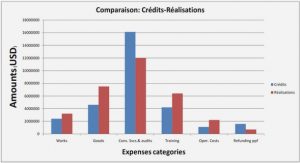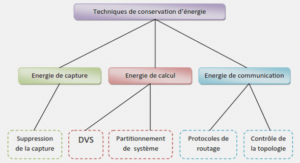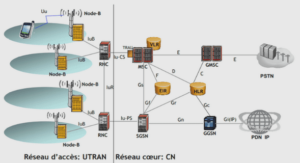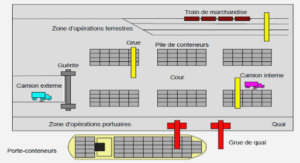Duration of xylogenesis in black spruce lengthened between 1950 and 2010
Materials and methods
Study area and xylem sampling
The study was conducted on black spruce in the Saguenay-Lac-Saint-Jean area, in the boreal forest of Quebec, Canada. The region has a gently rolling topography with hills reaching 500-700 m a.s.l. on thick and undifferentiated glacial till deposits. Four sites [Simoncouche (abbreviated as SIM), Bernatchez (BER), Mistassibi (MIS) and Camp Daniel (DAN)] were identified in mature even-aged black spruce stands at different altitudes and latitudes to obtain as wide as possible a range in the dynamics of tree growth and to select stands where the absence of evidence of human impact assured that trees had developed under the influence of natural disturbances only (figure 2.1, Table 2.1). In each site, the dominant or codominant 120-140-year-old trees with upright stems and similar growth rates were chosen (Dufour et Morin, 2007).
In each site, tree-ring formation was studied from April to October during 2002-2010 in 5 (2002- 2005) and 10 (2006-2010) trees. The sample size was increased during 2006-2010 to improve accuracy and representativeness of the results. Wood microcores were collected weekly following a spiral trajectory on the stem from 30 cm below to 30 cm above breast height (1.3 m) using surgical bone sampling needles in 2002-2006 and Trephor in 2007-2010 (Dufour et Morin, 2007; Rossi et al9 2006a). From 21 to 26 microcores were collected annually from each tree, depending on the site and year. The very small wounds inflicted by the thin piercing tubes of the tools and the consequently narrow areas of traumatized tissues around the sampling points [within a circumference of about 1 cm around the hole (Forster et al, 2000)] allowed repeated samplings by microcore extraction. Samples usually contained the previous 4 or 5 tree rings and the developing annual layer with the cambial zone and adjacent phloem. Samplings were performed on the same tree for not more than 4-5 years and wood samples were always taken at least 5 cm apart to avoid getting resin ducts on adjacent cores. A disturbance reaction of the xylem to the wound spreading to adjacent samples only occurred occasionally.
The microcores were placed in Eppendorf microtubes with an ethanol solution (10% in water) and stored at 5 °C to avoid tissue deterioration. Microcores were oriented by marking the transverse side with a pencil under a stereo-microscope at magnifications of 10-20x? dehydrated with successive immersions in ethanol and D-limonene and embedded in paraffin (Rossi et al, 2006a). Transverse sections of 6-10 \im thickness were cut from the samples with a rotary microtome. The sections were stained with cresyl violet acetate (0.16% in water) and examined within 10-25 minutes under visible and polarized light at magnifications of 400-500x to differentiate the developing and mature xylem cells.
Microscopic observations
In each sample, the radial number of cells in the cambial zone, radial enlargement phase, cell wall thickening phase, and mature cells were counted along three radial rows. Rows with cells with large tangential sizes were selected, to ensure that only cells cut at their middle longitudinal part were considered. In cross section, cambial cells were characterized by thin cell walls and small radial diameters (Antonova & Stasova, 1997; Rossi et al, 2006b). The dormant cambium was composed of 3-5 closely-spaced cells. At the onset of cambial activity, the cambial zone began to widen rapidly (within a week) as the number of cells increased, revealing that cell division had started. During cell enlargement, the tracheids were composed of a protoplast still enclosed in the thin primary wall but with radial diameter at least twice that of a cambial cell. Deformed rows of tracheids were frequently observed in this phase, due to the enlargement process occurring despite strong compression between xylem tissues and bark. Observations under polarized light discriminated between enlarging and cell wall thickening tracheids (Thibeault-Martel et al9 2008). Because of the arrangement of cellulose microfibrils, the developing secondary walls shone when observed under polarized light. Instead, no glistening was observed in enlargement zones where the cells were still composed of just primary wall (Abe et al9 1997). The progress of cell wall lignification was detected with cresyl violet acetate reacting with the lignin (Rossi et al, 2006b). Lignification was shown by a colour change from violet to blue. The color change over the whole cell wall revealed the end of lignification and the tracheid reaching maturity (Gricar et al 52005).The cell number in the 3 rows was averaged for each sample and used to assess onset and ending of xylogenesis. In spring, when at least one horizontal row of cells was observed in the radial enlargement phase, xylem formation was considered to have begun. In late summer, when no further cell was observed in wall thickening and lignification phase, xylem formation was considered complete. The duration of xylogenesis was assessed as the number of days occurring between onset and ending of xylogenesis and was calculated as the average among trees for each studied site and year.
Datasets of air temperature
Two datasets of air temperature were used in this study and consisted of time series (i) measured in the four sites and (ii) estimated by a climatic model. Measured and estimated temperatures were used for the definition and application of the pheno logical model, respectively. For the first dataset, a standard weather station was installed in a forest gap on each site. Air temperature data were collected at 3 m from the soil every 15 minutes and recorded as averages every hour by means « of CR10X dataloggers (Campbell Scientific Corporation, Canada). Maximum and minimum values were later calculated from the 24 measurements per day. The second dataset consisted of air temperatures generated for the period 1950-2004 by the ANUSPLIN model of the Canadian Forestry Service. This model used a multi-variate non-parametric surface and point fitting approach to estimate the time series of maximum and minimum temperature corresponding to the location of each site according to the algorithm described by McKenney et al (2006). To verify the consistency of the modeled time series, linear regressions were performed between the measured and estimated temperatures for the overlapping years (2002- 2004).
|
Table des matières
RÉSUMÉ
REMERCIEMENTS
TABLE MATIÈRES
LISTE DE FIGURES
LISTE DES TABLEAUX
STRUCTURE DU MÉMOIRE
CHAPITRE I
1.1. Introduction générale
1.1.1. Sites d’étude
1.1.2. Structure de la méthodologie
1.1.2.1. Données météorologiques
1.1.2.2. Phénologie 2002-2010
1.1.2.3. Aperçu des outils statistiques utilisés
1.1.3. Objectifs et hypothèse
1.1.4. Références 1
CHAPITRE II
2.1. Duration of xylogenesis in black spruce lengthened between 1950 and 2010
2.1.1. Summary
2.2. Introduction
2.3. Materials and methods
2.4. Results
2.5. Discussion
2.6. Acknowledgements
2.7. References
CHAPITRE III
3.1. Conclusion général
3.2. Références
![]() Télécharger le rapport complet
Télécharger le rapport complet






